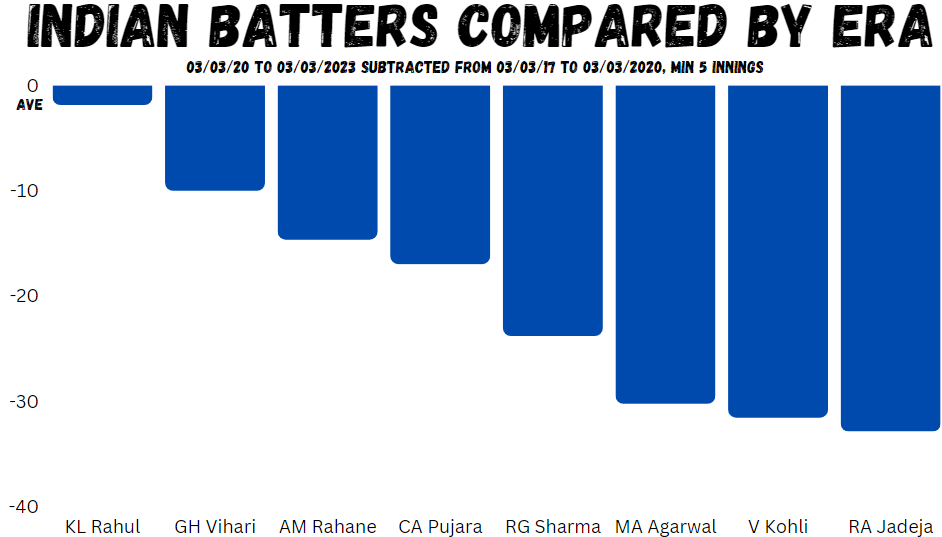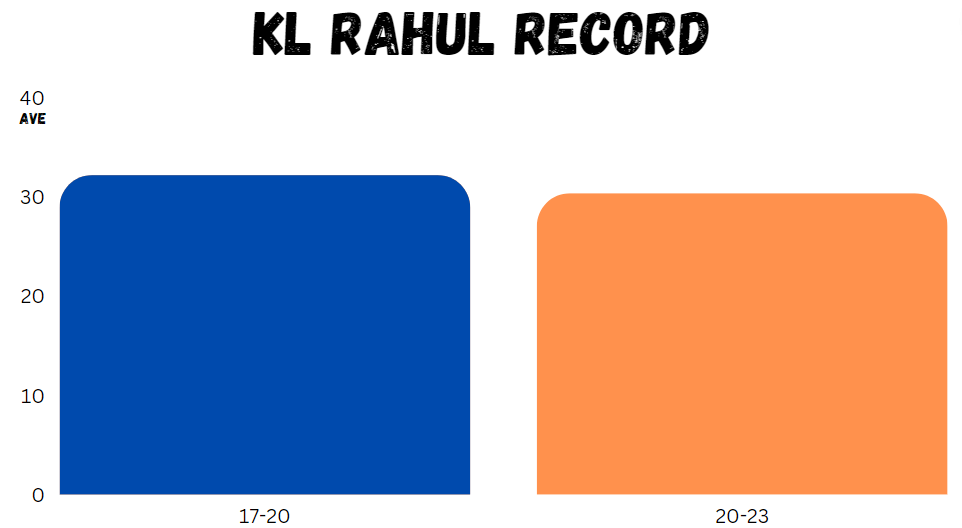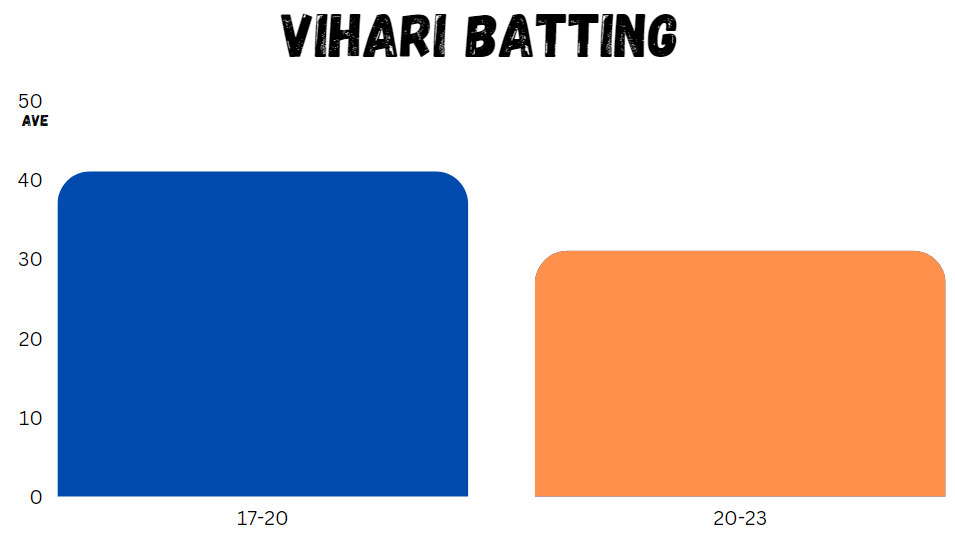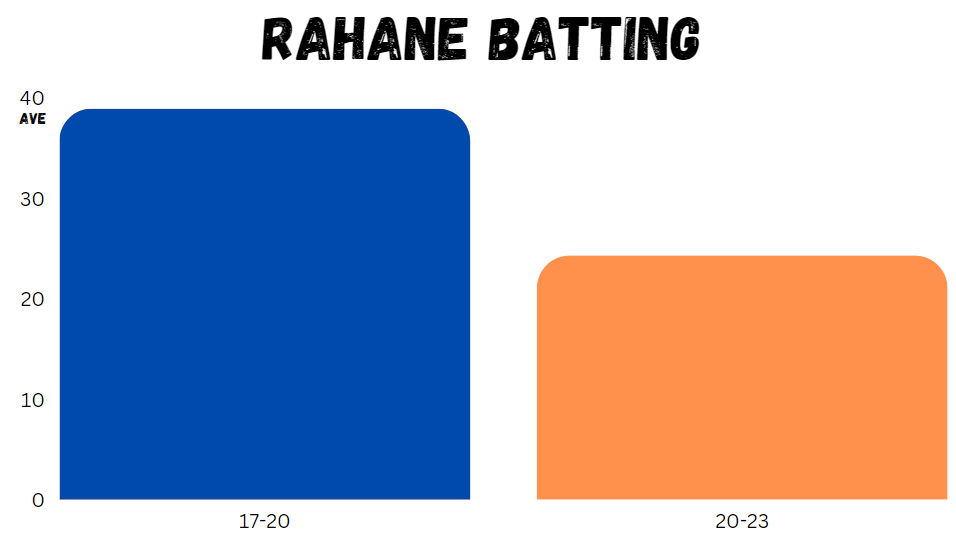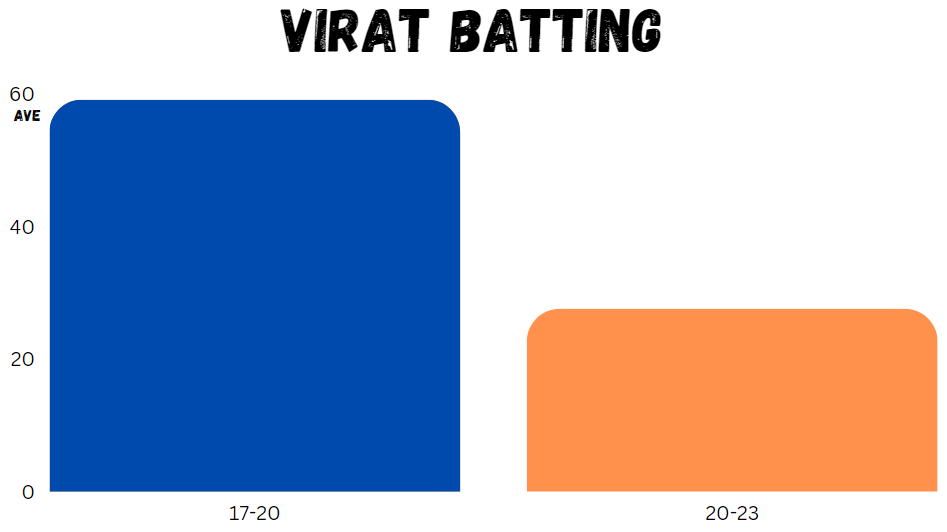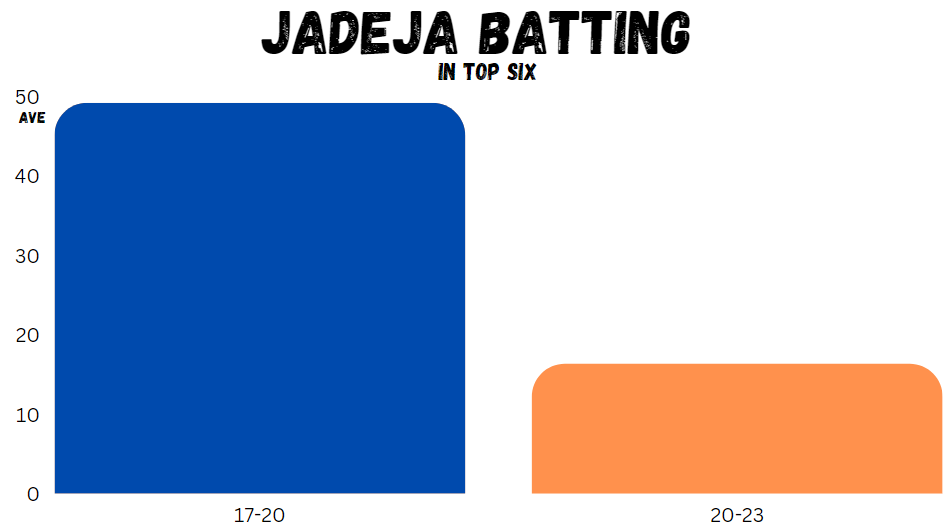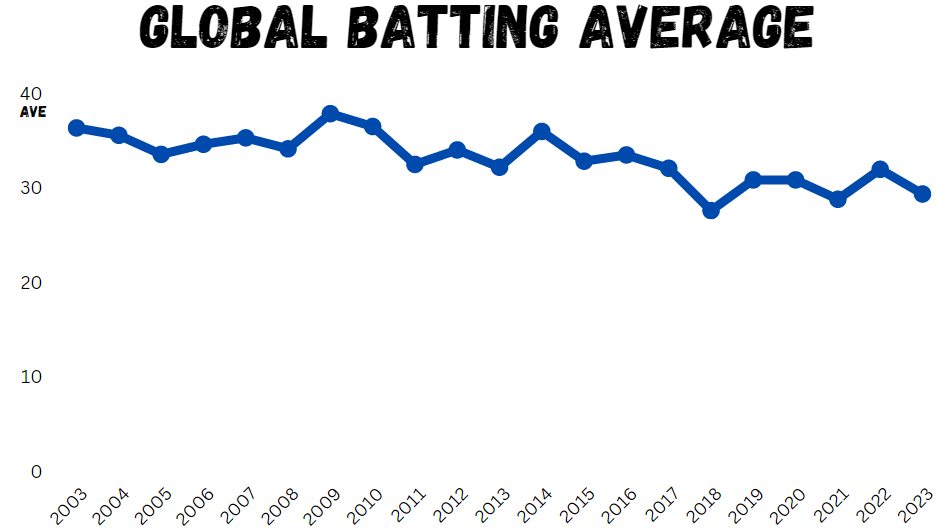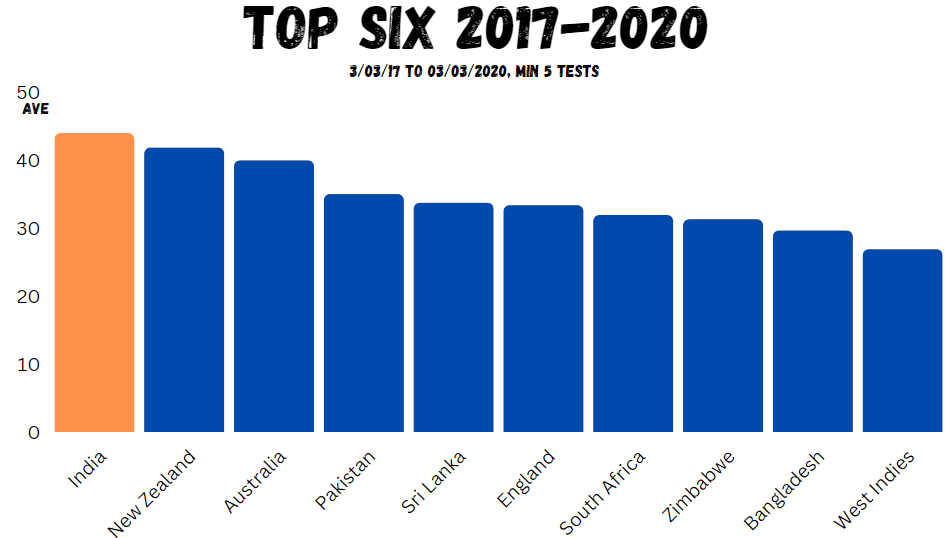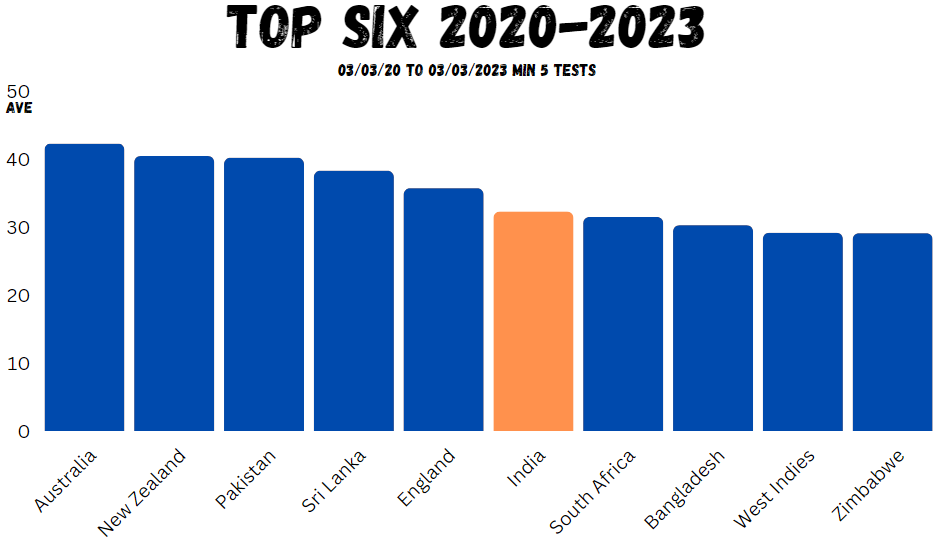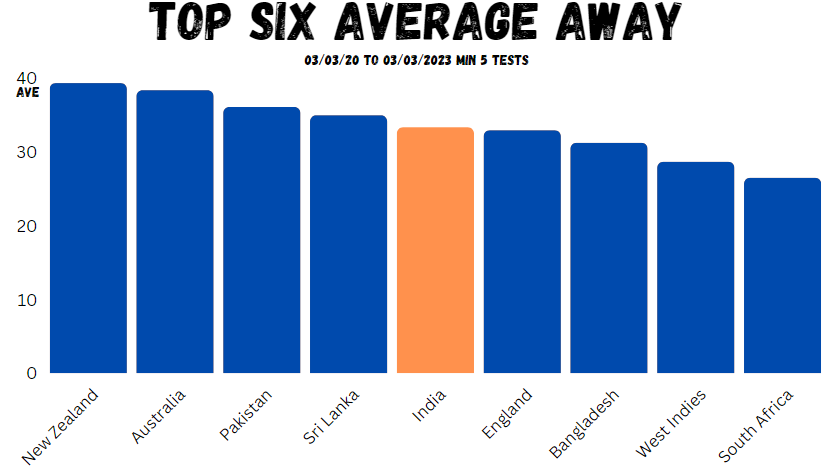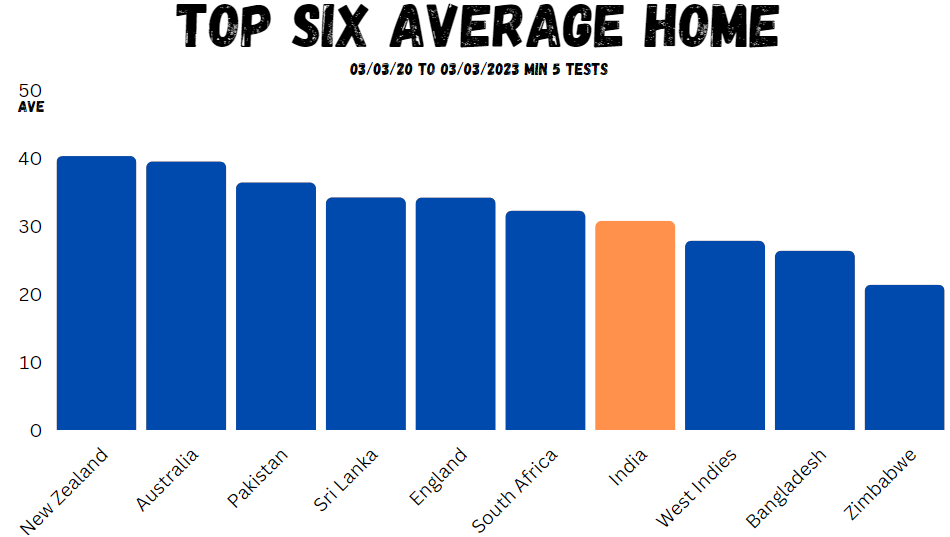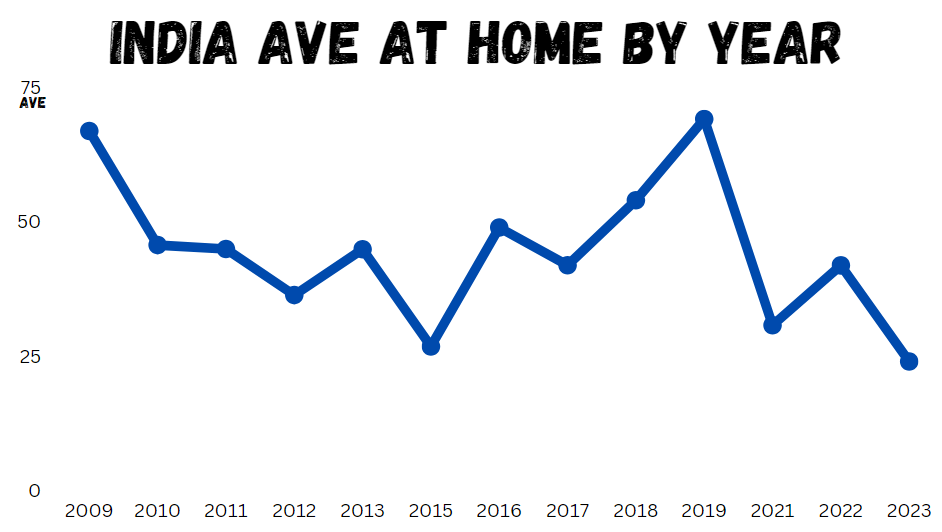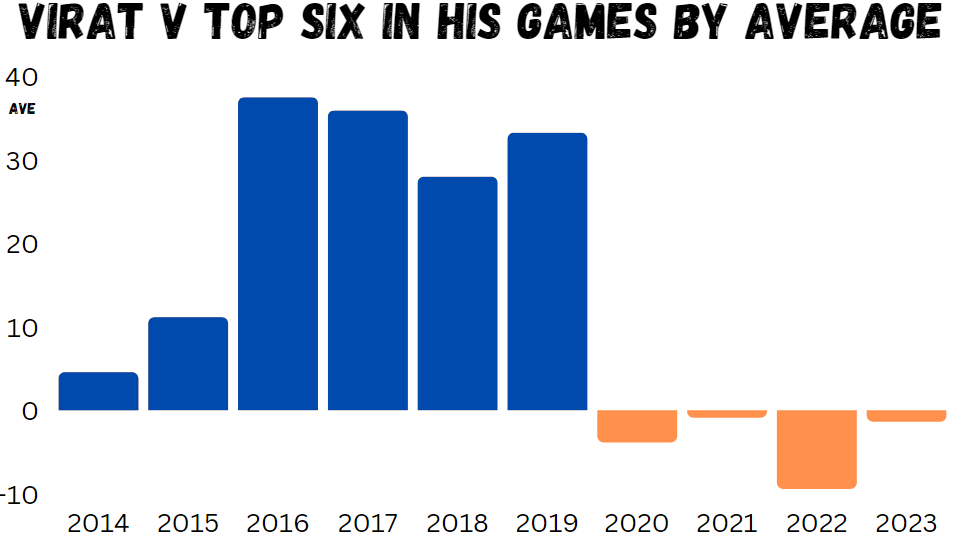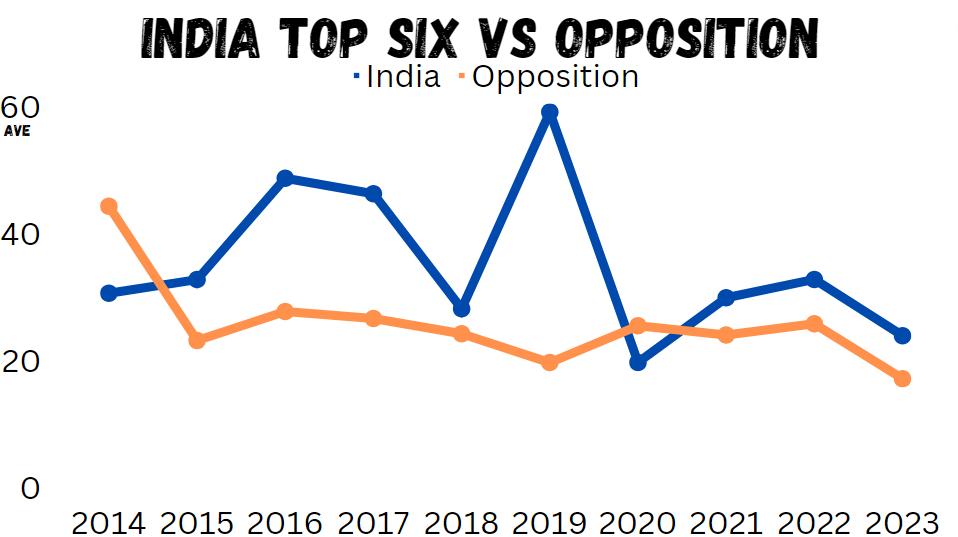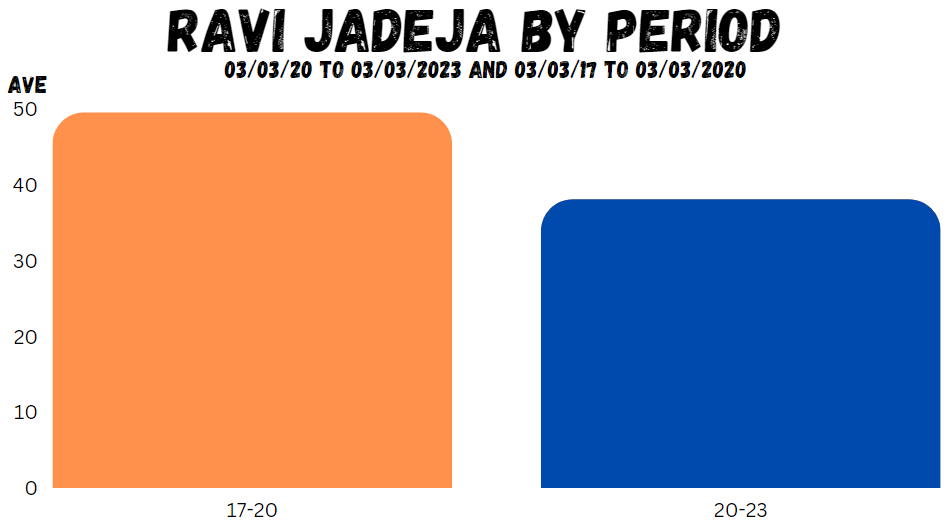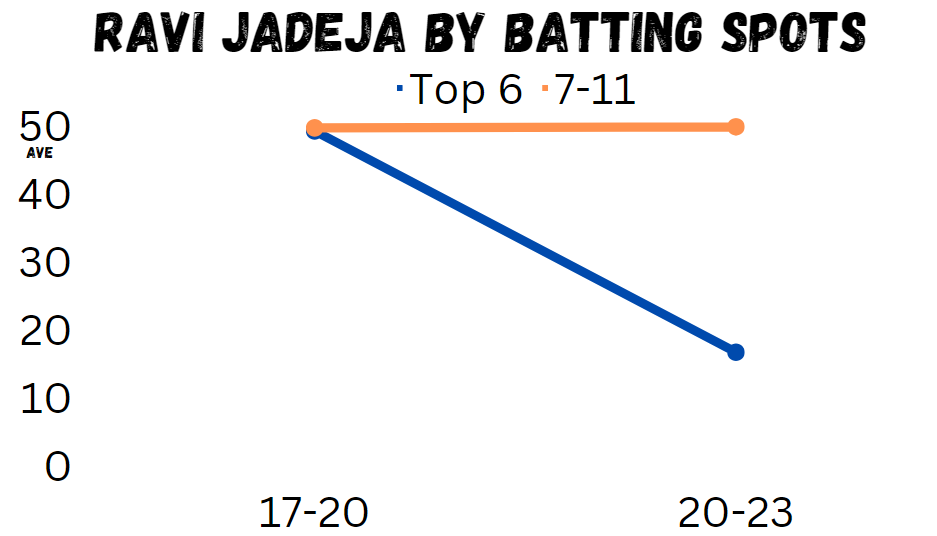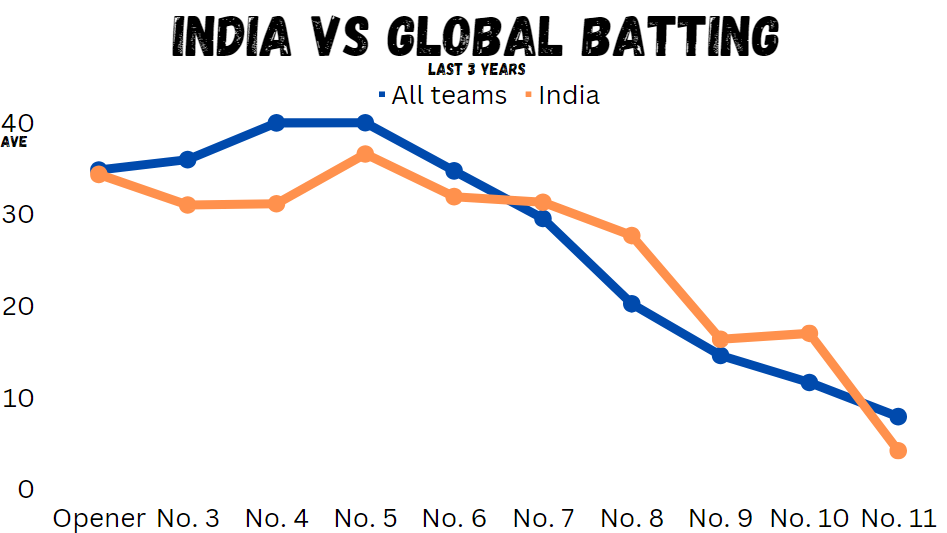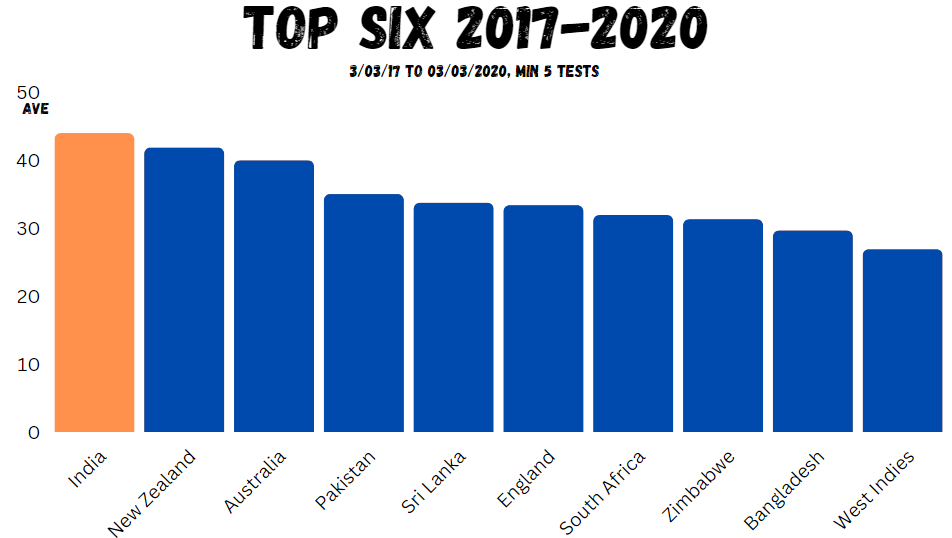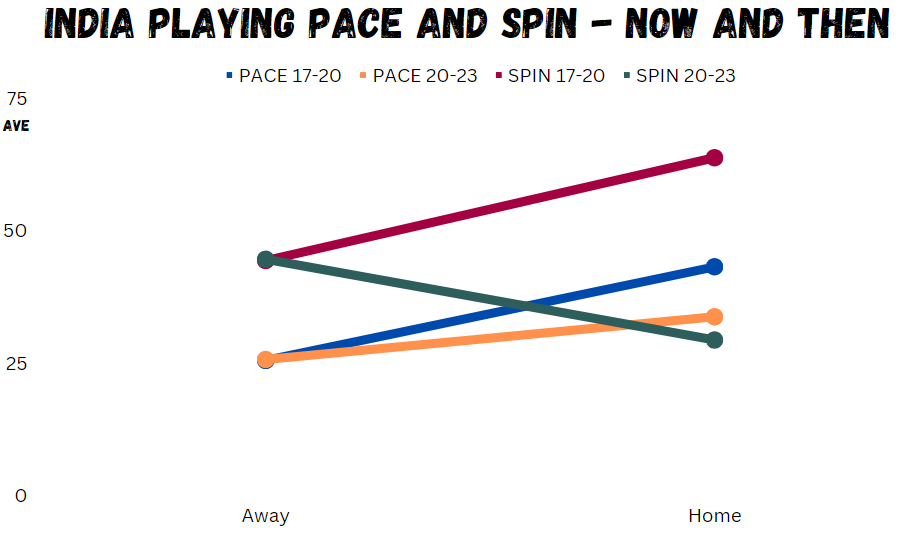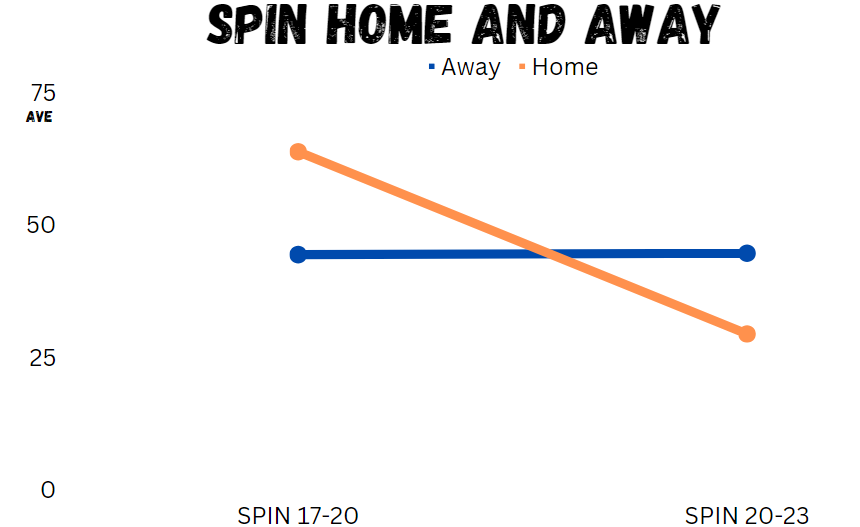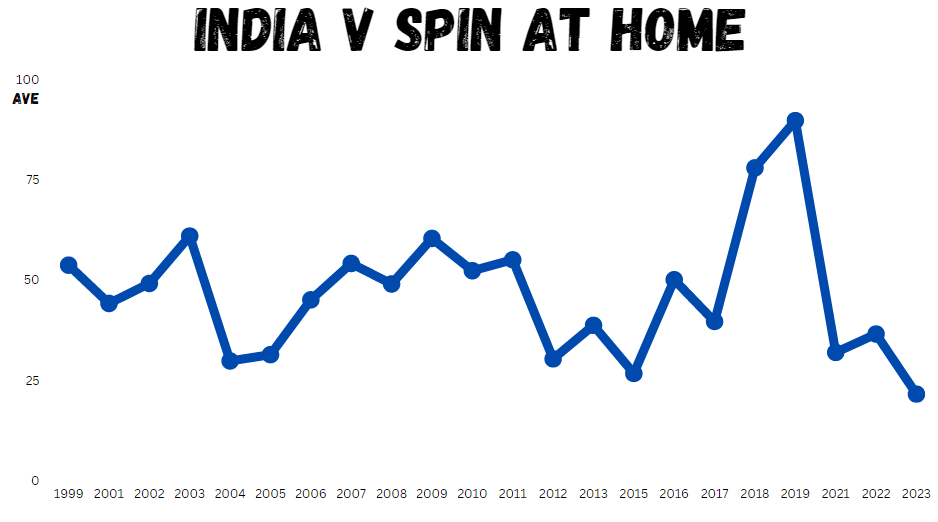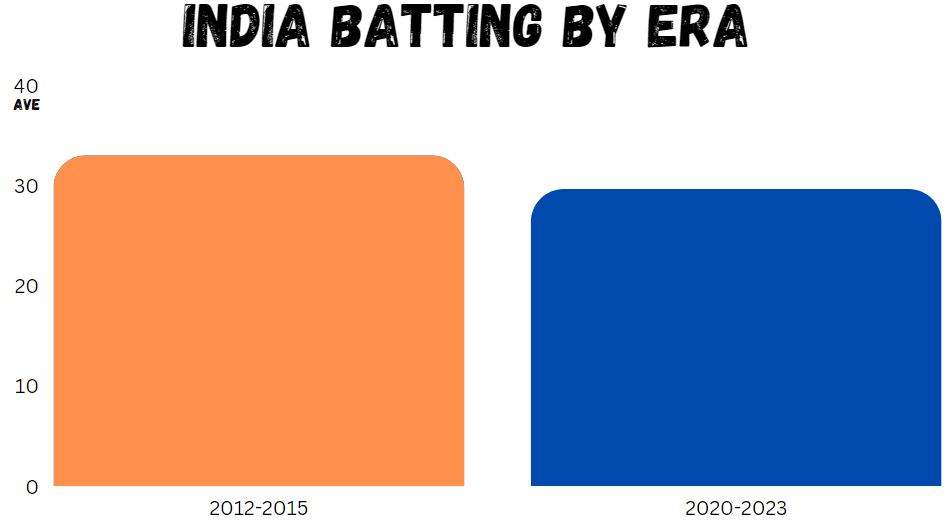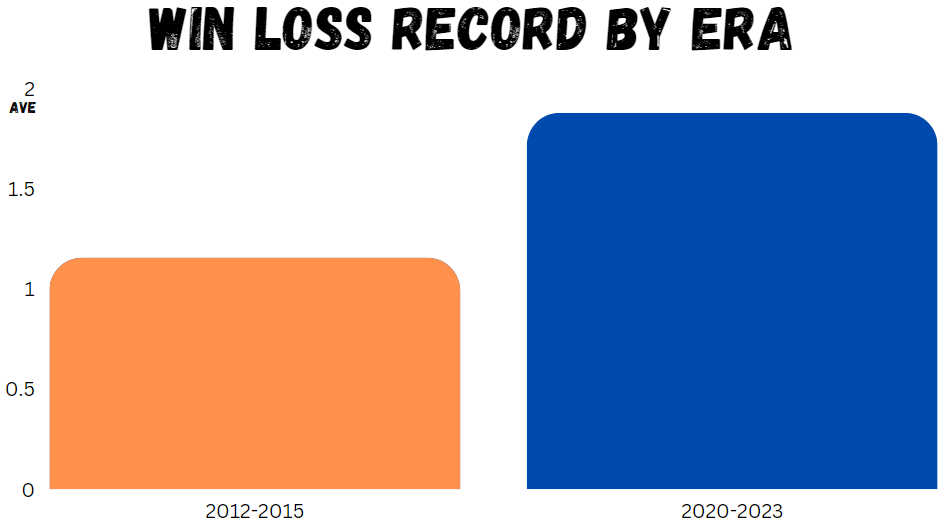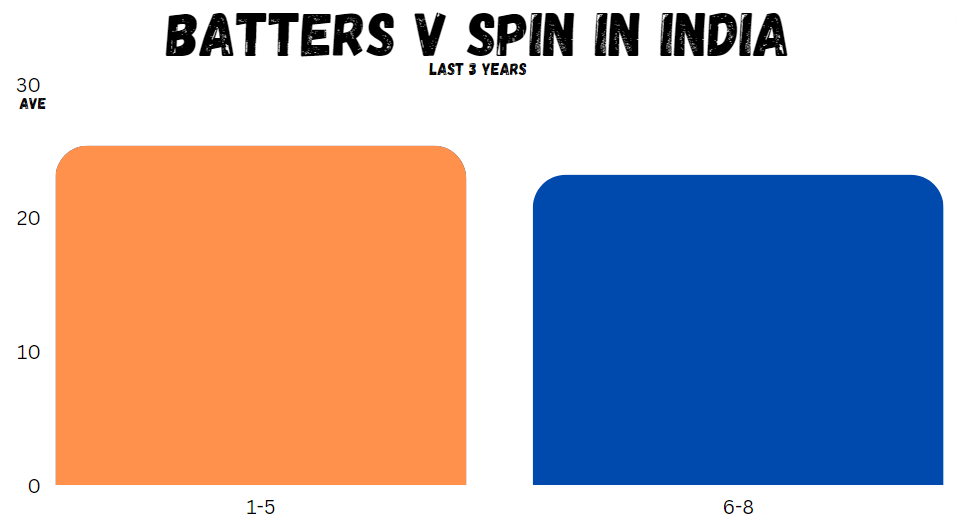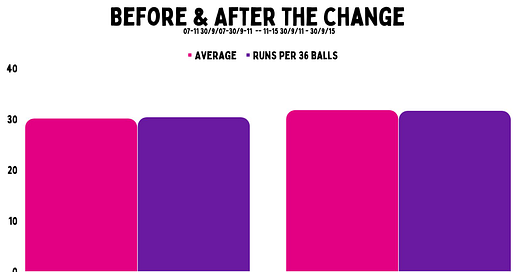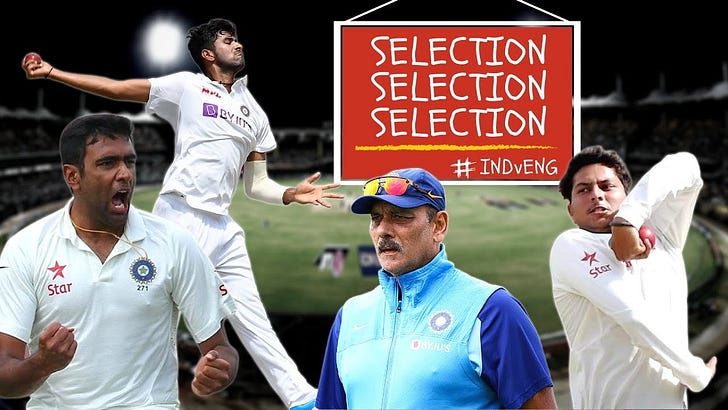
India and the three-year run drought
India's entire top six has stopped making runs, that is not players in form, that is a pattern.
Indian fans wanted Ajinkya Rahane gone, then Cheteshwar Pujara, but they got KL Rahul. Now it's either Virat Kohli or probably KS Bharat.
It's understandable why fans feel this way, but I am sensing a pattern here.
Either all of these guys became crap at the same time. Or someone invented a machine that only affects Indian batters.
But the more important thing is it's all Indian batters. And I do mean all.
This is every Indian batter who has played 5 innings in the top six taking their average of the last three years and subtracting their average of the period before.
I didn't cherry-pick or do anything cute. Just the last three years and the three before that.
Every single Indian top-order performance has fallen. It is absolutely fucken insane. How can one team fall this far in one discipline?
KL Rahul didn't have far to go to be fair, so his drop isn't like the others. But I would also assume that he is reaching his peak as a batter in terms of age, and also looking at what he has done in the IPL. So for him to still make fewer runs than an already low total is not great.
Hanuma Vihari was building a really nice career in the period before. Since he's not made many runs and is now seemingly out of favour at the age of 29. Hard to see him coming back now, yet he averages 57 in first class outside of Tests.
The Ajinkya Rahane case has been closed. But he was averaging nearly 40 before and was a road warrior for this team. He really struggled after that, and despite his leadership and slips fielding, he's gone.
Cheteshwar Pujara was going better before than Rahane and has continued since. That is why he's still in the side. But he wouldn't be if Twitter was a selector. But this has been just as tricky for him as anyone else.
Then you get to Rohit Sharma. He is still averaging 40 in this current period, so he doesn't get much flack. But it's still a 24-run drop from before. He's still averaging 50+ as an opener, but it's not looking as dynamic as before.
Mayank Agarwal was the only player here who doesn't average 50 at the first-class level. Though he's at 47. This is noteworthy as he was averaging 64 after 10 Tests. He was due a regression to the mean after that no matter what. He made 118 runs in his next five games. He actually held pretty form after that one dip, but the damage was done. He was another player who should have been in his prime and couldn't find a run.
We now have Virat Kohli, and I think people have covered this before. But the actual drop here is still absolutely incredible.
But let's get on to one that surprised me more. Ravi Jadeja. His is from the least amount of knocks, but everyone would consider him a batter now than in that previous period. But looking at this, it would be hard to make that argument. But remember this is him in the top six, he often batted at seven or low. And maybe this is the magic of small sample sizes, but this looks odd.
Those are the individual stories here. But when you see a pattern like this, it is hard to believe that just all these guys got terrible through separate causes. A few players losing form, sure, this can happen, an entire team forgetting to bat at one time would be one hell of a fluke. And being that six of the eight players were averaging over 40 before, these are not average players. These are good to elite to one of the best of all time for batting. Well, they were until they stopped making runs entirely.
And you might be thinking, well, this is the pace pandemic, and everyone is struggling to make runs in the last few years. You are right, global averages have plummeted, which started in 2017. So India held up well to start with and now aren't.
And they made runs in the 2017-2020 period. I mean, not just runs, the most runs per wicket. New Zealand and Australia are the only two teams in that period that are anywhere near them.
And then we come over here, and you can see that India is no longer at the top, nor are they even near the frontrunners at all; they are down with the batting dregs. They couldn't paddle in the deep end for fear of drowning.
So what does that look like when you compare each era? Pakistan has a bump from playing a lot at home. Sri Lanka decided not to be awful anymore. Australia had good batting, but a whole host of players actually found form. England got a baseball bump. West Indies had a few players come in or find their best form. Bangladesh and South Africa are the same as before. New Zealand lost Taylor and Watling in this period and started to play away a little more as well. Zimbabwe didn't play much. And then you have the real outlier. The only team that has massively changed how they bat with their top six is India.
Worth noting that this is a number for all the top six combined. They actually have dropped 11.62 runs per batter. Meaning that in each innings, the top six are 69.72 runs worse off than they were before. So if they bat two innings, that means India is 130 runs worse in the last three years than in the three before.
Now, we need to go a little deeper. Because this is where it gets fascinating. India are one of only two teams that average more away than home. Bangladesh - who I did not expect up here - is the other. Now it's only a small positive. But usually, most teams average less, so even being close to neutral is good. You see Sri Lanka, Australia and New Zealand in the normal range.
When you just look at the record away, it is not quite as impressive as this makes out. New Zealand has been the best batting team, and Australia are not far behind. Pakistan and Sri Lanka had fairly friendly schedules. But even so, India is only fifth.
But if away did not impress you that much, well, prepare to lose your shit over their home record. Because India's top six is only scoring more runs away than West Indies and Bangladesh. This is rough.
The average per game actually shows that they are probably batting slightly better at home. But perhaps they get fewer second innings to cash in on as the other team hasn't made enough runs. But this also shows that they regularly don't make runs at home either. They have only four innings averaging over 35 runs per wicket in a game. That is not normal for a home team. Certainly not for India.
This is them since 2009. You can see that this is their worst three-year period by a significant amount. And the thing is, we know this is intentional. They told us. This is not an accident. Their wickets are supposed to be tricky to bat on.
We just had the ICC fine them for a wicket, and Rohit Sharma said this was the kind of pitch India want. They are doing this on purpose. And it doesn't excuse their batting away from home. But of course, it is hard to get any confidence away if you're not making any tuns at home. In the old days, there would be heaps of tour games and first-class matches with your domestic team. No one does that anymore, so Indian batters are stuck, and clearly not handling it well.
This piece was inspired by two things: I noticed how far they had recently slipped in the global average rankings. Because this seemed abnormally low.
But I saw this Twitter thread from Random Cricket Stats that also looked at Virat Kohli's form compared to other players in his games. Because this is usually the best way to look at whether it is a bunch of players struggling, or something bigger. We already know the Indian batters are all struggling. But this factors in the opposition as well.

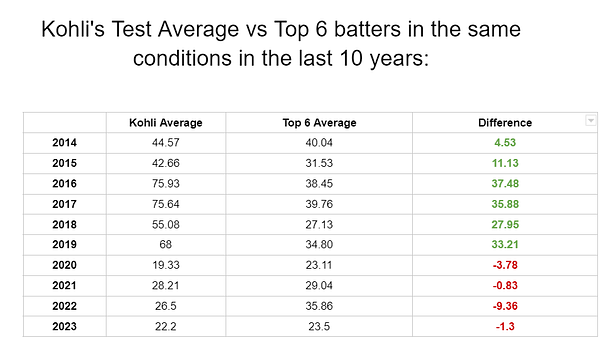
Kohli scored just an obscene amount of runs compared to everyone else in the 2016-19 period. He is clearly not like a normal batter at this point. But you will notice that even the averages of the other players batting in his matches get lower, and that isn't just his lack of runs. The pitches he batted on definitely got tougher.
In 2020 he has a 36-run swing, from plus 33 to minus three runs compared to the other batters in his matches. And he stays negative from then 2020. Only 2022 is truly awful. But for the best batter in the world, being a minus is below par for him, especially for this long. If everyone is batting worse, fine, that should shrink his average, but he should still be outperforming others, and he isn't.
Just to show this all as clear as I can. This is Kohli's runs ratio in those games compared to the combined top six of each team. This is better than just average differential, as averaging 45 in 300-par score games might be more demanding than averaging 50 in a 350-par game. But there is no way to show it that doesn't have Kohli dropping off a map.
But for India, this is why they aren't making runs. Their wickets are tougher. Home and away. You can see that in their opposition records. But the teams they play have had a small drop. India has been massive. Their top six averaged 59 in 2019, and 19 the following year. The same pattern we saw for Virat. You would expect the opposition to struggle as much, especially as India has the best bowling attack in the world. But they don't.
It's just that India is suddenly brought down to everyone else's level.
At the moment, you're probably trying to work out what stopped India's runs, and two theories. But for that, I have to show you two things. India's tail has stayed the exact same over the last three years and the three before. It's almost spooky how similar they are.
Now, Ravi Jadeja enters the conversation. He is the only player for India who has spent a lot of time up the order and down low in these two periods. But this is his overall batting average in each period. And it's pretty solid in both. Obviously better before, but nothing to really worry about.
Then we get to the good bit, you can see that in 2017-2020 he averaged 49 no matter where he batted. Now, well he still averages 49 when batting down the order, but when he goes up we see he cannot make a run. Now it is a small sample size, but this does feel like something really interesting, as he's the only one jumping around the order consistently. His record seems to suggest he's finding it much easier down back.
This is every other team in the world in the blue, and India is orange, looking at averages by position. India is behind in every single top-six spot in the last three years. Before their tail outperforms the world, only for the number 11 to join the top six.
Dare I even show you the one before this? Yeah, India was above average for every batting position except five and ten. This is just absurd.
But what happened?
There was something very interesting that happened, and we know it affected India. In late 2020, India were bowled out for 36. And from what I can tell - without Kookaburra confirming it - this was the first time the reinforced seam ball was used. But I looked at it by location and new ball versus old ball. And all I found was that India were about the same against both versions of Kookaburra when facing pace in Australia, South Africa and New Zealand. The new balls did not affect them.
And at this point, my head hurts.
This is what the inside of my brain looks like now. A collection of lines pointing in directions that probably mean something. But within this is our answer. But we need to pair it back a bit.
This is just pace. Home and away, in our periods. Ok, so this is pretty clear. Away has had no change. They were struggling in the pace pandemic like everyone else when not at home. But you can see that the average against pace at home has cratered.
Now, that might seem weird as the pitches are better for spin, not pace. However as wickets are falling quicker due to the tweaks, it means the pacers get more fresh batters and also only get bowled when the team is pretty sure they will be helpful. So, it isn't pace.
And it is not spin away because again, they are doing pretty similar against spin when they travel. But they have lost half of their runs at home, more than. They were averaging over 60 against spin at home, and now it's less than 30.
So the only reason the Indian batters weren't hit by the pace pandemic earlier like everyone else was they would go home and feast on the spin. Their decision to juice the pitches has ended that.
Here it is, this is India's average versus spin every year since 2000 that they have played at home. You can see that they only have one other period where they average anything near this low. And that was from 2012-2015.
Their average in that period overall was 33 runs per wicket, so almost four more than now. Because the pitches were so flat around the world they could make more runs elsewhere. But they won only 15 of 36 Tests in total.
In this period they have averaged 29, but they have played 26 and won 15. There are two differences, their bowling hadn't quite assembled at that point, and 12-15 was a batting era. So 33 is more than 29, but in an era when everyone was scoring runs, the extra four runs were still below par. On the other hand, averaging 29 now is enough to still have a good record.
One last thing I should mention is the early wickets thing. The highest-scoring batting position versus spin in India right now is number six. In no normal circumstances should that be the case. Even number seven is doing better than the fives, and eights are not that far off them either.
In fact, when you group the entire top five together and then do the same with six to eight, you can see that the averages are almost identical. Usually, the first group would average eight more at least. The top order is struggling because the wickets seem to be reacting a lot more to the brand-new ball and only getting easy when it is soft. Even with your number six being your worst specialist, your number seven usually possesses a second skill to get them in the team and your number eight is a bowler first. They are basically as useful as your top order. This is crazy.
India has historically been a great place to bat, meaning their batters all have fantastic averages compared to other countries. Now it is not, and with the rest of the world struggling to bat as well. It means there is nowhere to hide for an Indian batter. No home, not away, not on social media.
Conditions are about as tough for Indian batters as they have ever been.
It should mean that we are factoring that into the new lower scores. How much more - or less - you score than an average top-order player is now a good metric to look at for Indian batters. But where is the fun in that when you can just suggest they should all be dropped?






